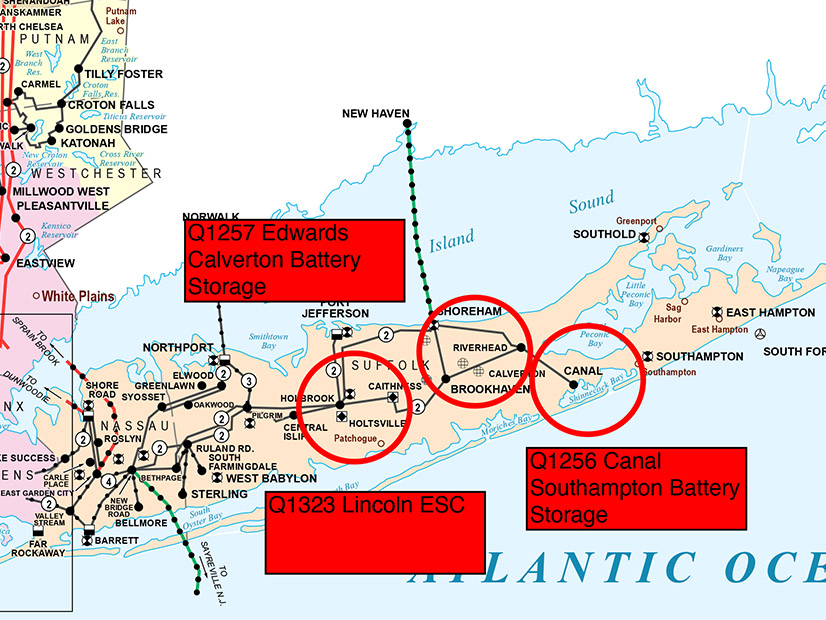
About 40% of the proposed capacity seeking interconnection in NYISO’s class year 2021 is not deliverable without expensive transmission upgrades, the ISO told the Operating Committee Aug. 18.
To obtain capacity resource interconnection service (CRIS) — required for projects to participate in the NYISO’s wholesale capacity market — projects must be found “deliverable” at their requested CRIS level. If a project fails the applicable deliverability tests, system deliverability upgrades (SDUs) are required to obtain CRIS. Projects can proceed without committing to accept SDUs if they are willing to participate only in the ISO’s energy market.
The ISO’s Facility Studies Preliminary Deliverability Analysis Draft Report, which was approved by the committee Thursday, estimated that if all projects in the 2021 Class Year accept their cost allocations in the initial decision round, almost $1.5 billion in upgrades would be required for the 16 projects found not deliverable, 10 of them on Long Island.
If all 10 of the projects on Long Island proceed, the SDUs would cost an estimated $914 million (±50%) in upgrades, including two phase angle regulator (PAR)-controlled 138-kV lines, uprating of six 69-kV lines, and addition of a third circuit between the EGC tap and Valley Stream 138-kV line.
Five solar projects in the Thousand Island area near the St. Lawrence River that failed the deliverability test would require an estimated $200 million (±50%) to rebuild 25 miles of the Taylorville-Boonville lines 5 and 6 if all five projects proceed with their requested CRIS.
The 650-MW Swiftsure Energy Storage project in New York City would need to commit to funding an SDU, including a PAR-controlled 345-kV line between the Goethals 345-kV station and the W. 49th Street 345-kV station, at an estimated $382 million (±50%), to obtain CRIS.
Developers whose projects failed the deliverability tests have been given 10 days to decide whether to proceed to additional SDU studies, which would provide binding cost estimates.
The 2021 class year included 55 projects totaling 10,148 MW that requested CRIS, including seven wind projects totaling 3,076 MW; 22 solar projects (2,650 MW); 23 energy storage projects (2,902 MW); and one 270-MW solar/storage hybrid project. Also in the class were two projects related to the Champlain Hudson Power Express’s plans to inject 1,250 MW at the New York Power Authority’s Astoria Annex 345-kV substation.
New York City (Zone J, 13 projects, 2,818 MW), Long Island (Zone K, 10 projects, 2,867 MW) and the Central area (Zone C, seven projects, 785 MW) had the majority of the projects.
Interconnection Study Process Questioned
The ISO’s review of the reliability impact study for an 80-MW solar project seeking to connect to a 115-kV line on National Grid’s Niagara Mohawk Power (NYSE:NGG) system prompted questions about the grid operator’s study processes from Operating Committee Chair Matt Antonio, an operations manager at National Grid’s control center.
The Tabletop Solar Project (queue #869) would connect on the Clinton Substation-Clinton Tap 115-kV line in Montgomery County, N.Y.
The ISO found the project caused N-1-1 thermal overloads and N-1-1 over- and under-voltages in the study area. The thermal overloads were fully mitigated by re-dispatching the generation at the Moses-Saunders dam on the St. Lawrence River. The high-voltage violations observed were mitigated or brought to pre-project voltages by turning on a reactor at Coopers Corner. The low-voltage conditions observed were mitigated by changing the tap positions of Rotterdam transformers 7 and 8 and the Inghams PAR after the first level contingency.
“I don’t believe that [the report] reflects reality, and how the system would actually be operated,” said Antonio. Re-dispatching Moses-Saunders “may be an answer, but it isn’t necessarily the answer that would be taken in real-time.”
Antonio also questioned the report’s finding of an instability problem, which the ISO ultimately determined was present in the pre-project base case. He said such reports should be subject to a “sanity check” before they are released to ISO members for approval. “The report was put out saying there’s a stability issue pre-project. So that’s worrisome,” he said.
The ISO said the issue appears to be a modeling discrepancy in the pre-project case and agreed to investigate the modeling issue further.
The ISO’s Thinh Nguyen said the grid operator didn’t find it necessary to hold off on Operating Committee approval of the study report, saying there was no need “to hold the project hostage” when the problem is with the base case and not because of the project itself. He said finding the cause of the modeling discrepancy is “like finding a needle in a haystack,” but committed to investigate it further to avoid confusion in future studies.
Antonio said he would like to see the ISO’s process “more streamlined … more thorough and more accurate.”
Nguyen closed the meeting by announcing that ISO officials will present plans for improving the interconnection process at the next Transmission Planning Advisory Subcommittee meeting Sept. 1.
He said the ISO improved its portal to increase the transparency to project stakeholders in April and is seeking to hire two project managers to provide “one-on-one service” to project developers. In addition, the ISO is seeking to add two stakeholder services representatives to help manage stakeholder inquiries related to the interconnection process.
Antonio asked if the ISO was attempting to shorten the process, saying National Grid must refer potential customers to the ISO for connecting loads larger than 10 MW. “It’s tough to explain to a customer, and occasionally they make the decision that New York isn’t the place for them because of how long it takes,” he said.
Nguyen responded that the ISO plans to “streamline the scope without jeopardizing the reliability of the system.”


